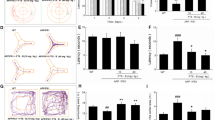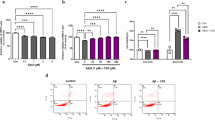Abstract
Purpose
Pomegranate fruit, Punica granatum L. (Punicaceae), and its constituents have been shown to inhibit inflammation. In this study, we aimed to assess the effects of freeze-dried pomegranate (PWE) on PGE2 production in IL-1β-stimulated SK-N-SH cells.
Methods
An enzyme immunoassay (EIA) was used to measure prostaglandin E2 (PGE2) production from supernatants of IL-1β-stimulated SK-N-SH cells. Expression of COX-2, phospho-IκB, and phospho-IKK proteins was evaluated, while NF-κB reporter gene assay was carried out in TNFα-stimulated HEK293 cells to determine the effect of PWE on NF-κB transactivation. Levels of BACE-1 and Aβ in SK-N-SH cells stimulated with IL-1β were measured with an in cell ELISA.
Results
PWE (25–200 μg/ml) dose dependently reduced COX-2-dependent PGE2 production in SK-N-SH cells stimulated with IL-1β. Phosphorylation of IκB and IKK was significantly (p < 0.001) inhibited by PWE (50–200 μg/ml). Our studies also show that PWE (50–200 μg/ml) significantly (p < 0.01) inhibited NF-κB transactivation in TNFα-stimulated HEK293 cells. Furthermore, PWE inhibited BACE-1 and Aβ expression in SK-N-SH cells treated with IL-1β.
Conclusions
Taken together, our study demonstrates that pomegranate inhibits inflammation, as well as amyloidogenesis in IL-1β-stimulated SK-N-SH cells. We propose that pomegranate is a potential nutritional strategy in slowing the progression of neurodegenerative disorders such as Alzheimer’s disease.








Similar content being viewed by others
References
Blennow K, de Leon MJ, Zetterberg H (2006) Alzheimer’s disease. Lancet 368:387–403
Castellani RK, Rolston RK, Smith MA (2010) Alzheimer disease. Dis Mon 56:484–546
Selkoe DJ (2001) Alzheimer’s disease. Genes, proteins, and therapy. Physiol Rev 81:741–766
Messmer K, Reynolds GP (2005) An in vitro model of inflammatory neurodegeneration and its neuroprotection. Neurosci Lett 388:39–44
Chen CH, Zhou W, Liu S, Deng Y, Cai F, Tone M, Tone Y, Tong Y, Song W (2012) Increased NF-κB signalling up-regulates BACE1 expression and its therapeutic potential in Alzheimer’s disease. Int J Neuropsychopharmacol 15:77–90
HoshinoT NT, Homan T, Tanaka K, Sugimoto Y, Araki W, Narita M, Narumiya S, Suzuki T, Mizushima T (2007) Involvement of prostaglandin E2 in production of amyloid-peptides both in vitro and in vivo. J Biol Chem 282:32676–32688
Yasojima K, Schwab C, McGeer EG, McGeer PL (1999) Distribution of cyclooxygenase-1 and cyclooxygenase-2 mRNAs and proteins in human brain and peripheral organs. Brain Res 830:226–236
Montine TJ, Sidell KR, Crews BC, Markesbery WR, Marnett LJ, Roberts LJ 2nd, Morrow JD (1999) Elevated CSF prostaglandin E2 levels in patients with probable AD. Neurology 53:1495–1498
Paris D, Patel N, Quadros A, Linan M, Bakshi P, Ait-Ghezala G, Mullan M (2007) Inhibition of Abeta production by NF-kappaB inhibitors. Neurosci Lett 415:11–16
Bales KR, Du Y, Dodel RC, Yan GM, Hamilton-Byrd E, Paul SM (1998) The NF–kappaB/Rel family of proteins mediates Abeta-induced neurotoxicity and glial activation. Brain Res Mol Brain Res 57:63–72
Marwarha G, Raza S, Meiers C, Ghribi O (2014) Leptin attenuates BACE1 expression and amyloid-β genesis via the activation of SIRT1 signaling pathway. Biochim Biophys Acta 1842:1587–1595
Bourne KZ, Ferrari DC, Lange-Dohna C, Rossner S, Wood TG, Perez-Polo JR (2007) Differential regulation of BACE1 promoter activity by NFB in neurons and glia upon exposure to Ab peptides. J Neurosci Res 85:1194–1204
Buggia-Prevot V, Sevalle J, Rossner S, Checler F (2008) NFkappaB-dependent control of BACE1 promoter transactivation by Abeta42. J Biol Chem 283:10037–10047
Guglielmotto M, Aragno M, Tamagno E, Vercellinatto I, Visentin S, Medana C, Catalano MG, Smith MA, Perry G, Danni O, Boccuzzi G, Tabaton M (2012) AGEs/RAGE complex upregulates BACE1 via NF-κB pathway activation. Neurobiol Aging 33:196-e13–196-e27
Camandola S, Poli G, Mattson MP (2000) The lipid peroxidation product 4-hydroxy-2,3-nonenal inhibits constitutive and inducible activity of nuclear factor kappa B in neurons. Brain Res Mol Brain Res 85:53–60
Lee SI, Kim BS, Kim KS, Lee S, Shin KS, Lim JS (2008) Immunosuppressive activity of punicalagin via inhibition of NFAT activation. Biochem Biophys Res Commun 371:799–803
Romier B, Van De Walle J, During A, Larondelle Y, Schneider YJ (2008) Modulation of signalling nuclear factor-kappaB activation pathway by polyphenols in human intestinal Caco-2 cells. Br J Nutr 100:542–551
Oucharif A, Khalki H, Chaib S, Mountassir M, Aboufatima R, Farouk L, Benharraf A, Chait A (2012) Comparative study of the anti-inflammatory and antinociceptive effects of two varieties of Punica granatum. Pharm Biol 50:429–438
Lee CJ, Chen LG, Liang WL, Wang CC (2010) Anti-inflammatory effects of Punica granatum Linne in vitro and in vivo. Food Chem 118:315–322
Olajide OA, Kumar A, Velagapudi R, Okorji U, Fiebich BL (2014) Punicalagin inhibits neuroinflammation in LPS-activated rat primary microglia. Mol Nutr Food Res 58:1843–1851
Seeram NP, Lee R, Hardy ML, Heber D (2005) Large scale purification of ellagitannins from pomegranate husk, a by-product of the commercial juice industry. Sep Purif Technol 41:49–55
Olajide OA, Velagapudi R, Okorji U, Sarker S, Fiebich BL (2014) Picralima nitida seeds suppress PGE2 production by interfering with multiple signalling pathways in IL-1β-stimulated SK-N-SH neuronal cells. J Ethnopharmacol 152:377–383
Decker T, Lohmann-Matthes ML (1988) A quick and simple method for the quantitation of lactate dehydrogenase release in measurements of cellular cytotoxicity and tumor necrosis factor (TNF) activity. J Immunol Methods 115:61–69
Sutinen EM, Pirttilä T, Anderson G, Salminen A, Ojala JO (2012) Pro-inflammatory interleukin-18 increases Alzheimer’s disease-associated amyloid-β production in human neuron-like cells. J Neuroinflamm 9:199
Pasinetti GM, Aisen PS (1998) Cyclooxygenase-2 expression is increased in frontal cortex of Alzheimer’s disease brain. Neuroscience 87:319–324
Lim GP, Yang F, Chu T, Chen P, Beech W, Teter B, Tran T, Ubeda O, Ashe KH, Frautschy SA, Cole GM (2000) Ibuprofen suppresses plaque pathology and inflammation in a mouse model for Alzheimer’s disease. J Neurosci 20:5709–5714
Romier-Crouzet B, Van De Walle J, During A, Joly A, Rousseau C, Henry O, Larondelle Y, Schneider YJ (2009) Inhibition of inflammatory mediators by polyphenolic plant extracts in human intestinal Caco-2 cells. Food Chem Toxicol 47:1221–1230
Ahmed S, Wang N, Hafeez BB, Cheruvu VK, Haqqi TM (2005) Punica granatum L. extract inhibits IL–1beta-induced expression of matrix metalloproteinases by inhibiting the activation of MAP kinases and NF-kappa B in human chondrocytes in vitro. J Nutr 135:2096–2102
Sinha S, Anderson JP, Barbour R, Basi GS, Caccavello R, Davis D, Doan M, Dovey HF, Frigon N, Hong J, Jacobson-Croak K, Jewett N, Keim P, Knops J, Lieberburg I, Power M, Tan H, Tatsuno G, Tung J, Schenk D, Seubert P, Suomensaari SM, Wang S, Walker D, Zhao J, McConlogue L, John V (1999) Purification and cloning of amyloid precursor protein beta-secretase from human brain. Nature 402:537–540
Luo Y, Bolon B, Kahn S, Bennett BD, Babu-Khan S, Denis P, Fan W, Kha H, Zhang J, Gong Y, Martin L, Louis JC, Yan Q, Richards WG, Citron M, Vassar R (2001) Mice deficient in BACE1, the Alzheimer’s beta-secretase, have normal phenotype and abolished beta-amyloid generation. Nat Neurosci 4:231–232
Lei F, Xing DM, Xiang L, Zhao YN, Wang W, Zhang LJ, Du LJ (2003) Pharmacokinetic study of ellagic acid in rat after oral administration of pomegranate leaf extract. J Chromatogr B Analyt Technol Biomed Life Sci 796:189–194
Shukla M, Gupta K, Rasheed Z, Khan KA, Haqqi TM (2008) Bioavailable constituents/metabolites of pomegranate (Punica granatum L) preferentially inhibit COX2 activity ex vivo and IL–1beta-induced PGE2 production in human chondrocytes in vitro. J Inflamm (Lond) 5:9
Seeram NP, Lee R, Heber D (2004) Bioavailability of ellagic acid in human plasma after consumption of ellagitannins from pomegranate (Punica granatum L.) juice. Clin Chim Acta 348:63–68
Bialonska D, Kasimsetty SG, Khan SI, Ferreira D (2009) Urolithins, intestinal microbial metabolites of Pomegranate ellagitannins, exhibit potent antioxidant activity in a cell-based assay. J Agric Food Chem 57:10181–10186
Farbood Y, Sarkaki A, Dianat M, Khodadadi A, Haddad MK, Mashhadizadeh S (2015) Ellagic acid prevents cognitive and hippocampal long-term potentiation deficits and brain inflammation in rat with traumatic brain injury. Life Sci 124:120–127
Acknowledgments
This study was carried out in part with funding by the Alexander von Humboldt Foundation to Dr. Olumayokun Olajide. We wish to thank Mr. Oluwatodimu Sam-Dahunsi for assisting with freeze-drying of pomegranate juice.
Author information
Authors and Affiliations
Corresponding author
Ethics declarations
Conflict of interest
On behalf of all authors, the corresponding author states that there is no conflict of interest.
Rights and permissions
About this article
Cite this article
Velagapudi, R., Baco, G., Khela, S. et al. Pomegranate inhibits neuroinflammation and amyloidogenesis in IL-1β-stimulated SK-N-SH cells. Eur J Nutr 55, 1653–1660 (2016). https://doi.org/10.1007/s00394-015-0984-0
Received:
Accepted:
Published:
Issue Date:
DOI: https://doi.org/10.1007/s00394-015-0984-0




